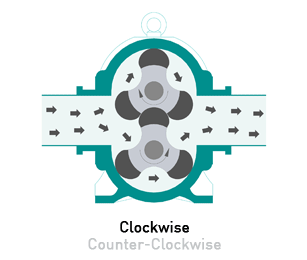How do Rotary Lobe Pumps Work?
Rotary lobe pumps, which are self-priming positive displacement pumps, are not sensitive to dry running. The synchronized rotation of the rotor pair and the increasing suction chamber create a vacuum on the priming side of the pump. This vacuum draws the liquid into the pump chamber and the pumped medium is conveyed past the pump wall into the pressure area by the rotors. The synchronized rotation of the rotor pair and the decreasing pressure chamber create an overpressure on the discharge side of the pump. The flow direction can easily be reversed by changing the direction of rotation.
What are some applications in which rotary lobe pumps can operate?
Membrane Filtration (water / wastewater) – this procedure can utilize water-permeable membranes to separate particles from water that needs to be cleaned. Rotary lobe pumps extract the water to be purified through the membranes, which have tiny pores through which the water permeates. Solids, bacteria, and other organic compounds are typically retained by the membranes, thereby purifying the water. Because cleaning the membranes occasionally requires back-flushing with filtered water, using a rotary lobe pump that can operate ‘in reverse’ makes it easier to clean the membranes.
Mobile Pumps used for Flood Relief – the U.S. is currently in the middle of ‘flood season’, so it’s helpful to acknowledge that rotary lobe pumps can be used for flood relief. Self-priming rotary lobe pumps can be mounted on mobile trailers for use in flood and disaster recovery applications as well as for non-permanent work in canals, pumping station support, and wastewater treatment.
Coastal Protection – there has been significant effort in the last couple decades to fight sea pollution. After unfortunate oil spills, pumps are usually needed for clean-up operations; rotary lobe pumps can be used as transfer pumps to convey the oil over long stretches to collection tanks or tanker vehicles.




